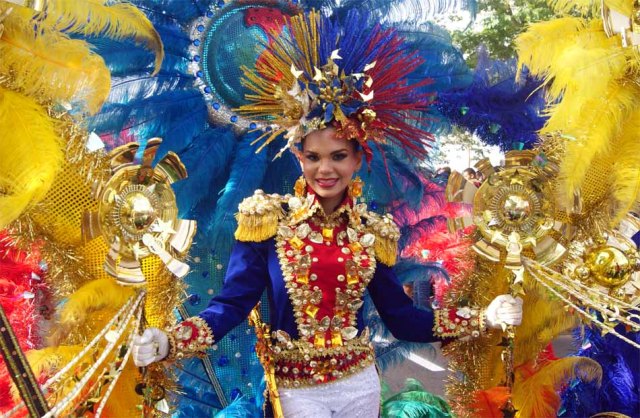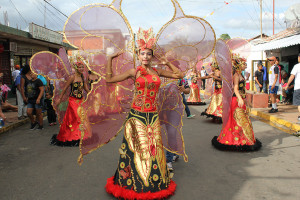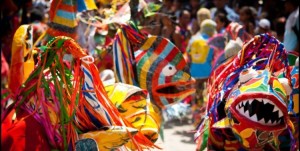One of the most popular celebrations of Venezuela and the world’s most remote
There is no doubt that Carnival is one of the most multicultural festivals, because of its origins and varieties within Western culture. The word comes from the Italian carnevale; composed of the Latin words caro-carni, meaning ashes and meat, and the verb vale, that means relief, shake off. This defines what we call the three days before Lent that leads to Easter.
 Carnival integrated customs, traditions and ritual acts of diverse cultures and different eras. It goes back to ancient Egypt. In addition, in ancient Greece, recalling the essence of the carnival took place in playful and satirical celebrations. The Dionysian festivals (god of wine) gave way to its expression. However, the Catholic Church instituted Carnival as a Christian festival in the Roman period. The purpose was to let Christian societies have three days of celebrations, where they had the opportunity to have inhibitions with alcohol, sexual acts and represent opposite role plays to whom they were (the rich to poor, the male to female and the old to child). In this way they could be ready and prepared for the forty days of penance and abstinence, in honor of all those days that Jesus spent in the desert.
Carnival integrated customs, traditions and ritual acts of diverse cultures and different eras. It goes back to ancient Egypt. In addition, in ancient Greece, recalling the essence of the carnival took place in playful and satirical celebrations. The Dionysian festivals (god of wine) gave way to its expression. However, the Catholic Church instituted Carnival as a Christian festival in the Roman period. The purpose was to let Christian societies have three days of celebrations, where they had the opportunity to have inhibitions with alcohol, sexual acts and represent opposite role plays to whom they were (the rich to poor, the male to female and the old to child). In this way they could be ready and prepared for the forty days of penance and abstinence, in honor of all those days that Jesus spent in the desert.
Many islands in the Caribbean, Latin-American countries, like Brazil and Europe, especially Italy, live it big. In Venezuela they celebrated Carnival since colonial times. In the 1700s, Caracas was famous for its crazy carnival celebrations, by excess of alcohol and lack of prohibitions. In the period of Guzman Blanco, in the late 1800s, this festival acquired another character. Musical groups, parades, a beauty pageant contest, drama, inversion role plays and children games. The tossing of water, flour and eggs, was popularized at that time and still remains a popular activity in all corners of the country.
Today, in specific areas of Venezuela, people continue organizing great festivals around Carnival, making them their own, because of the area and culture where they live.
Carnival of Callao
 One of the most famous carnivals in Venezuela is held in the southern mining town Callao. The array of costumes and its Calypso music make them unique in the country, due to the influence of British, Dutch and Caribbean cultures that coexisted there on the basis of the mining work.
One of the most famous carnivals in Venezuela is held in the southern mining town Callao. The array of costumes and its Calypso music make them unique in the country, due to the influence of British, Dutch and Caribbean cultures that coexisted there on the basis of the mining work.
The word Calypso comes from a nymph in Greek mythology, whose beauty and feminine attributes failed to convince Odysseus to leave his family and his roots. A parade of costumed dancers accompanies musicians. Among them, we find the famous ‘madam’ characters, who are inspired by the matrons of the carnivals of the islands of Guadeloupe and Martinique. We also find the characters of the devils, the daubs and the women in their colourful costumes dancing on the parade. The most famous character is the black lady Isidora, Queen of Calypso.
Local musicians play whistles, rattles, maracas and their special drum called Bumbac. Their lyrics are a fusion of Spanish language, dialect spoken in the islands and also words from Nigeria and Senegal, known as Kaico.
Hammock Carnival
This celebration takes place in Puerto Cabello, a town in the northeast coast. Its origin comes from the Netherlands and Curacao; so socio-economic exchanges were also given here. They perform during Processions dramas and battles using sticks. The festivity ends with a party to the beat of drums.
‘Carnival Monday starts at night, with the simulation of the wake, after a walk through the village with the hammock, which is placed in the corner of the Cross … around many lighted candles. In the place the community gathers; drums and horns are playing and the people toast … On Tuesday … The Hammock out at shoulder women (who are men disguised) … they play roles that express pain … pointers-male or female-repeated rhythmically: hence the dead, there goes Hammock … while the companion group dances to the music … .Then, men begin a mock battles ending with sticks … when women invited them to dance the Venezuelan Drum music.’
Daria Hernández, Cecilia Fuentes. Fiestas tradicionales de Venezuela. Fundación Bigott, pg. 181
Burial of the Sardine
 In the central coast of Venezuela, the locals there celebrate what is known as the Burial of the Carnival, which is Ash Wednesday, especially in Naiguatá town.
In the central coast of Venezuela, the locals there celebrate what is known as the Burial of the Carnival, which is Ash Wednesday, especially in Naiguatá town.
‘It is one of the holiday traditions for greater participation in Naiguatá … Some prepare anxious the litter sardine in a wooden structure adorned with palm trees … in the centre there is the figure of the sardine made from cardboard … At 4pm locals will be ready to start the tour of the streets with de sardine … (the procession is led by the altar boy, the priest, the devil, the police, TV unit, widows and the queen are men disguised) … the celebration begins with the wake … when a sardine is placed in the ballot box … Musicians and people are added to the tragic procession to throw it into the water. Right now the battle begins and the game starts with water, in which the whole group is involved.’
Daria Hernández, Cecilia Fuentes. Fiestas tradicionales de Venezuela. Fundación Bigott, pg. 184 and 187
The famous Venezuelan musical band las Sardinas de Naiguatá (the Naiguatá Sardines) emerged from this festival and it is from where their artistic name derives. Their music has crossed the borders of this town and goes beyond this celebration. Venezuelan people from all over the country, listen to their music all year long.
Carnival is so important in Venezuela and other Latin American countries, because it marked an existential point of view, live and enjoy life. The Cuban singer Celia Cruz as expressed in her famous song:
Oh! We must not mourn, that life is a carnival and your pains go away by singing”
By Carla Soto
Images:
- http://atodomomento.com/venezuela-solicitara-declarar-carnavales-de-el-callao-como-patrimonio-de-la-humanidad/
- http://www.noticias24.com/fotos/noticia/5862/las-espectaculares-imagenes-de-los-carnavales-de-el-callao/
- http://ve.emedemujer.com/hogar/ser-padres/en-la-calle-se-celebra-el-carnaval/